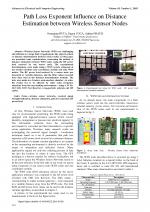| 1/2010 - 20 |
Path Loss Exponent Influence on Distance Estimation between Wireless Sensor NodesBUTA, G. |
| Extra paper information in |
| Click to see author's profile in |
| Download PDF |
Author keywords
wireless sensor networks, received signal strength indication, distance estimation, path loss exponent, RF power level
References keywords
No relevant keywords could be extracted from the references.
About this article
Date of Publication: 2010-02-27
Volume 10, Issue 1, Year 2010, On page(s): 110 - 115
ISSN: 1582-7445, e-ISSN: 1844-7600
Digital Object Identifier: 10.4316/AECE.2010.01020
Web of Science Accession Number: 000275458900020
SCOPUS ID: 77954677262
Abstract
Wireless Sensor Networks (WSN) are challenging and efficient in a large field of applications like object location or distance determination between sensor nodes. In this paper are presented some considerations concerning the method of distance estimation between WSN nodes using the RF power level received by one sensor node. The experimental determinations were made using a WSN system composed of ten wireless modules (one coordinator module and nine WSN nodes). The RF power level received by a sensor node was measured at variable distances, and the dBm values recorded were then used in the distance determination formula. The tests were made in a 3 meters semi-anechoic chamber - in order the results not to be affected by other radio frequency emissions from the surrounding environment - using a 20 Hz - 26.5 GHz EMI Test Receiver, a log-periodic antenna and RF cables. |
| References | | | Cited By «-- Click to see who has cited this paper |
| [1] J. K. Hart, K. Martinez, "Environmental Sensor Networks: A revolution in the earth system science?", Earth-Science Reviews, pp. 177-191, 2006 [CrossRef] [SCOPUS Times Cited 587] [2] 802.15.4 - IEEE Standard for Information Technology - Telecommunications and information exchange between systems. Part 15.4: Wireless Medium Access Control (MAC) and Physical Layer (PHY) Specifications for Low-Rate Wireless Personal Area Networks (LR-WPANs), 2003 [3] E. Coca, V. Popa, G. Buta, "Wireless Sensor Network nodes performance measurements and RSSI evaluation", SIITME - International Symposium for Design and Technology of Electronics Packages - Gyula, Hungary, 2009 [CrossRef] [SCOPUS Times Cited 8] [4] N. I. Wei, Z.-X., Wang, "Indoor Location Algorithm Based on the Measurement of the Received Signal Strength", Higher Education Press and Springer-Verlag, 2006 [CrossRef] [SCOPUS Times Cited 11] [5] Joe-Air Jiang, Cheng-Long Chuang, Chia-Pang Chen, Tzu-Shiang Lin, "A RSSI-based environmental-adaptive dynamic radiation power management for Wireless Sensor Networks", Circuits and Systems, APCCAS, 2008 [CrossRef] [SCOPUS Times Cited 7] Web of Science® Citations for all references: 0 SCOPUS® Citations for all references: 613 TCR Web of Science® Average Citations per reference: 0 SCOPUS® Average Citations per reference: 123 ACR TCR = Total Citations for References / ACR = Average Citations per Reference We introduced in 2010 - for the first time in scientific publishing, the term "References Weight", as a quantitative indication of the quality ... Read more Citations for references updated on 2025-07-01 19:26 in 29 seconds. Note1: Web of Science® is a registered trademark of Clarivate Analytics. Note2: SCOPUS® is a registered trademark of Elsevier B.V. Disclaimer: All queries to the respective databases were made by using the DOI record of every reference (where available). Due to technical problems beyond our control, the information is not always accurate. Please use the CrossRef link to visit the respective publisher site. |
Faculty of Electrical Engineering and Computer Science
Stefan cel Mare University of Suceava, Romania
All rights reserved: Advances in Electrical and Computer Engineering is a registered trademark of the Stefan cel Mare University of Suceava. No part of this publication may be reproduced, stored in a retrieval system, photocopied, recorded or archived, without the written permission from the Editor. When authors submit their papers for publication, they agree that the copyright for their article be transferred to the Faculty of Electrical Engineering and Computer Science, Stefan cel Mare University of Suceava, Romania, if and only if the articles are accepted for publication. The copyright covers the exclusive rights to reproduce and distribute the article, including reprints and translations.
Permission for other use: The copyright owner's consent does not extend to copying for general distribution, for promotion, for creating new works, or for resale. Specific written permission must be obtained from the Editor for such copying. Direct linking to files hosted on this website is strictly prohibited.
Disclaimer: Whilst every effort is made by the publishers and editorial board to see that no inaccurate or misleading data, opinions or statements appear in this journal, they wish to make it clear that all information and opinions formulated in the articles, as well as linguistic accuracy, are the sole responsibility of the author.



